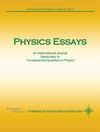A test to the constancy of the velocity of light with our solar system
IF 0.5
Q4 PHYSICS, MULTIDISCIPLINARY
引用次数: 0
Abstract
This article is a detailed proposal of an astronomical test to be carried out within our solar system to try to detect the eventual addition of the speed of a celestial body to that of its emitted light -that reflected of the Sun in this case. This eventuality could be determined by observing the consequent variation in its apparent position that could produce the variation of the angle of aberration, a consequence, in turn, of the variation of the velocity of its emitted light. This area is chosen, despite having here celestial bodies with lower speeds than those of the stars, and their consequent lower sensitivity in the observations, to avoid the inconvenience of the enormous interstellar distances, which could disqualify the results of the test due to the possible intervention of the phenomenon of extinction of the light wave in that distances, as we will see in the Introduction of this article. To carry out the above, we need to have celestial bodies of different radial speeds with respect to our Earth, and in this area, we find them in the satellites of the other planets in the extreme positions of their orbits; and the observation of the possible different aberrations, in the variation of the apparent separations of the satellites from their planets in those positions. The proposal also includes the observation of the transit of a satellite across the front of its planet to detect the possible appearance of this phenomenon also in this different circumstance. It will also be possible to determine if it is the relative speed between the light source and the observer the one that effectively intervenes in this phenomenon of light aberration—planetary in this case—or if it is only that of the observer—that of our Earth—that produces it, as several authors maintain. To adequately illustrate the proposed test, and the order of magnitude of the intervening parameters, a specific example is developed with Jupiter and two of its satellites: IO and METIS.测试光速与太阳系的恒定性
这篇文章详细介绍了在太阳系内进行的一项天文试验,目的是探测一个天体的速度是否最终增加了其发射光的速度--这里指的是太阳的反射光。这种可能性可以通过观察天体视位置的变化来确定,视位置的变化会产生像差角的变化,而像差角的变化又是天体发射光速度变化的结果。尽管这里的天体速度比恒星低,因此观测灵敏度也较低,但我们还是选择了这一区域,以避免巨大的星际距离带来的不便,因为在这一距离上,光波消散现象可能会导致测试结果不合格,我们将在本文的导言中看到这一点。为了完成上述工作,我们需要相对于地球而言具有不同径向速度的天体,在这方面,我们可以在其他行星的卫星轨道的极端位置上找到这些天体;还可以在这些位置上观测卫星与其行星的视距变化中可能存在的不同像差。该建议还包括观测卫星从其行星前方穿过的情况,以探测在这种不同的情况下是否也可能出现这种现象。此外,还可以确定光源和观测者之间的相对速度是否有效地干预了这种光像差现象--在这种情况下是行星速度--或者是否只是观测者的速度--即我们地球的速度--产生了光像差,正如一些作者所坚持的那样。为了充分说明所提议的测试以及干预参数的数量级,我们以木星及其两颗卫星 IO 和 METIS 为例进行了具体说明。
本文章由计算机程序翻译,如有差异,请以英文原文为准。
求助全文
约1分钟内获得全文
求助全文
来源期刊

Physics Essays
PHYSICS, MULTIDISCIPLINARY-
自引率
83.30%
发文量
50
审稿时长
6-12 weeks
期刊介绍:
Physics Essays has been established as an international journal dedicated to theoretical and experimental aspects of fundamental problems in Physics and, generally, to the advancement of basic knowledge of Physics. The Journal’s mandate is to publish rigorous and methodological examinations of past, current, and advanced concepts, methods and results in physics research. Physics Essays dedicates itself to the publication of stimulating exploratory, and original papers in a variety of physics disciplines, such as spectroscopy, quantum mechanics, particle physics, electromagnetic theory, astrophysics, space physics, mathematical methods in physics, plasma physics, philosophical aspects of physics, chemical physics, and relativity.
 求助内容:
求助内容: 应助结果提醒方式:
应助结果提醒方式:


